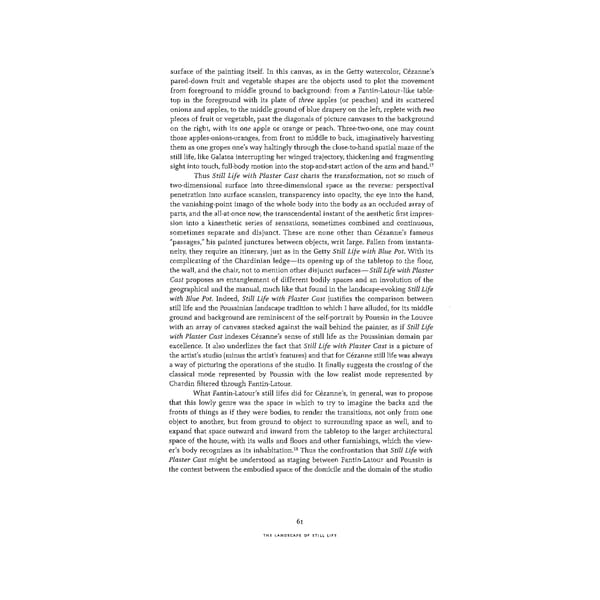surface of the painting itself. In this canvas, as in the Getty watercolor, Cezanne's pared-down fruit and vegetable shapes are the objects used to plot the movement from foreground to middle ground to background: from a Fantin-Latour-like table- top in the foreground with its plate of three apples (or peaches) and its scattered onions and apples, to the middle ground of blue drapery on the left, replete with two pieces of fruit or vegetable, past the diagonals of picture canvases to the background on the right, with its one apple or orange or peach. Three-two-one, one may count those apples-onions-oranges, from front to middle to back, imaginatively harvesting them as one gropes one's way haltingly through the close-to-hand spatial maze of the still life, like Galatea interrupting her winged trajectory, thickening and fragmenting 17 sight into touch, full-body motion into the stop-and-start action of the arm and hand. Thus Still Life with Plaster Cast charts the transformation, not so much of two-dimensional surface into three-dimensional space as the reverse: perspectival penetration into surface scansion, transparency into opacity, the eye into the hand, the vanishing-point imago of the whole body into the body as an occluded array of parts, and the all-at-once now, the transcendental instant of the aesthetic first impres- sion into a kinesthetic series of sensations, sometimes combined and continuous, sometimes separate and disjunct. These are none other than Cezanne's famous "passages," his painted junctures between objects, writ large. Fallen from instanta- neity, they require an itinerary, just as in the Getty Still Life with Blue Pot. With its complicating of the Chardinian ledge—its opening up of the tabletop to the floor, the wall, and the chair, not to mention other disjunct surfaces — Still Life with Plaster Cast proposes an entanglement of different bodily spaces and an involution of the geographical and the manual, much like that found in the landscape-evoking Still Life with Blue Pot. Indeed, Still Life with Plaster Cast justifies the comparison between still life and the Poussinian landscape tradition to which I have alluded, for its middle ground and background are reminiscent of the self-portrait by Poussin in the Louvre with an array of canvases stacked against the wall behind the painter, as if Still Life with Plaster Cast indexes Cezanne's sense of still life as the Poussinian domain par excellence. It also underlines the fact that Still Life with Plaster Cast is a picture of the artist's studio (minus the artist's features) and that for Cézanne still life was always a way of picturing the operations of the studio. It finally suggests the crossing of the classical mode represented by Poussin with the low realist mode represented by Chardin filtered through Fantin-Latour. What Fantin-Latour's still lifes did for Cezanne's, in general, was to propose that this lowly genre was the space in which to try to imagine the backs and the fronts of things as if they were bodies, to render the transitions, not only from one object to another, but from ground to object to surrounding space as well, and to expand that space outward and inward from the tabletop to the larger architectural space of the house, with its walls and floors and other furnishings, which the view- 18 er's body recognizes as its inhabitation. Thus the confrontation that Still Life with Plaster Cast might be understood as staging between Fantin-Latour and Poussin is the contest between the embodied space of the domicile and the domain of the studio 61 THE LANDSCAPE OF STILL LIFE
 Cézanne in the Studio: Still Life in Watercolors Page 75 Page 77
Cézanne in the Studio: Still Life in Watercolors Page 75 Page 77